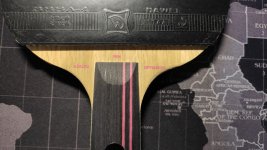This user has no status.
This user has no status.
Active Member
After gluing and removing rubbers from a Yinhe Earth 3, which has a really smooth finish on the blade face, and a Korbel, which has a less smooth surface than Yinhe (for my surprise), I noticed something obvious. It is much easier to apply glue and remove rubbers from a smoother surface.
Based on this, since we seal the blades basically to prevent it from splintering when removing the rubbers, what about sanding the surface to get a really smooth surface instead of sealing it?
Off course I’m talking about the finest grit sandpapers to only work on the smoothness, and not to remove thickness. Also, using a straight block and all proper care.
My only concern is if the water on the water based glue could do actual damage to the blade over time.
Based on this, since we seal the blades basically to prevent it from splintering when removing the rubbers, what about sanding the surface to get a really smooth surface instead of sealing it?
Off course I’m talking about the finest grit sandpapers to only work on the smoothness, and not to remove thickness. Also, using a straight block and all proper care.
My only concern is if the water on the water based glue could do actual damage to the blade over time.











